Wisconsin is known as the Dairy State and the famous grasslands of Wisconsin are a great habitat for snakes as well as for cattle. There are also more than 12,000 lakes in Wisconsin including the famous twin lakes that the capital, Madison, sits between.
The cold winters of Wisconsin are tough for many animals to take but the cold doesn’t seem to stop snakes from settling in Wisconsin. There are more than 20 different native snakes in this state including some water snakes that are commonly found in the state’s many lakes and rivers.
Discover 22 Snakes in Wisconsin
Some of the common snakes that you’ll find throughout Wisconsin are:
Smooth Green Snake
Smooth green snakes are found almost everywhere in Wisconsin except in the very southern part of the state. These snakes are easy to spot because of their bright green color. They also have a very smooth appearance because of the way that their scales lay which is why this snake is called the smooth green snake. Smooth green snakes have solid bright green color that usually stands out, but in the summertime the vivid green Wisconsin vegetation can hide these small snakes. They are typically about a foot or a foot and a half long but never get longer than two feet.
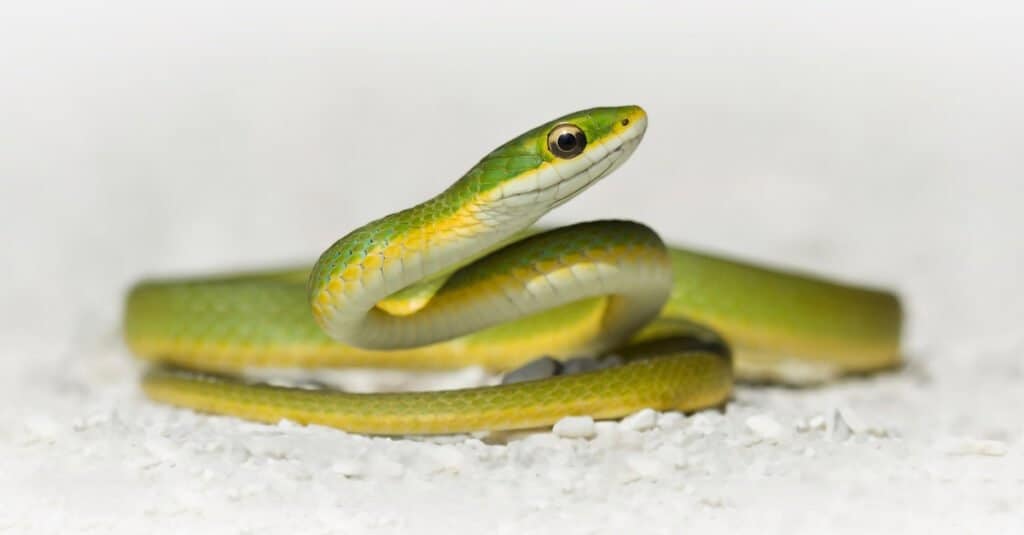
Smooth green snakes are found almost everywhere in Wisconsin except in the very southern part of the state.
©Kristian Bell/Shutterstock.com
Western Ribbon Snake
In Wisconsin western ribbon snakes are relatively rare. They are most often seen in the southern end of Wisconsin or in the central region. These snakes generally are about two feet long and they have dark green or black scales with three yellow or orange reddish stripes that run down the entire length of their bodies on their back and sides. Western ribbon snakes are totally harmless to humans and if you leave them alone they will leave you alone.
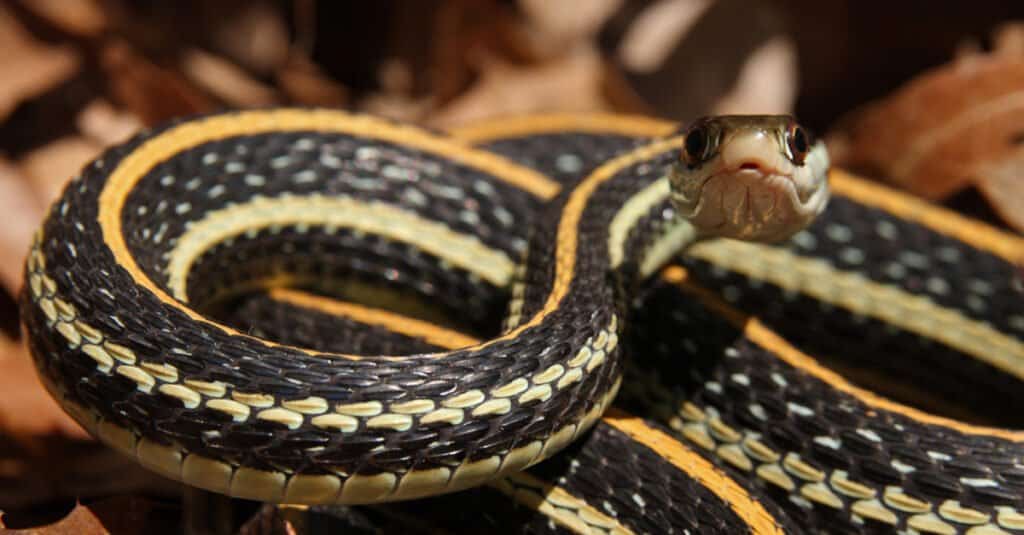
In Wisconsin western ribbon snakes are relatively rare. They are most often seen in the southern end of Wisconsin or in the central region.
©Ryan M. Bolton/Shutterstock.com
Northern Ring-Necked Snake
Northern ring-necked snakes are small snakes. They only reach a length of about two feet. They like to live on the edges of forests and near deciduous trees, which there are a lot of in Wisconsin. Typically northern ring-necked snakes are found on the edges of Wisconsin forests or in rural and suburban areas in agricultural fields and back yards. During the winter they may take up residence in old tree stumps or other areas that will protect them the cold and snow of a Wisconsin winter.
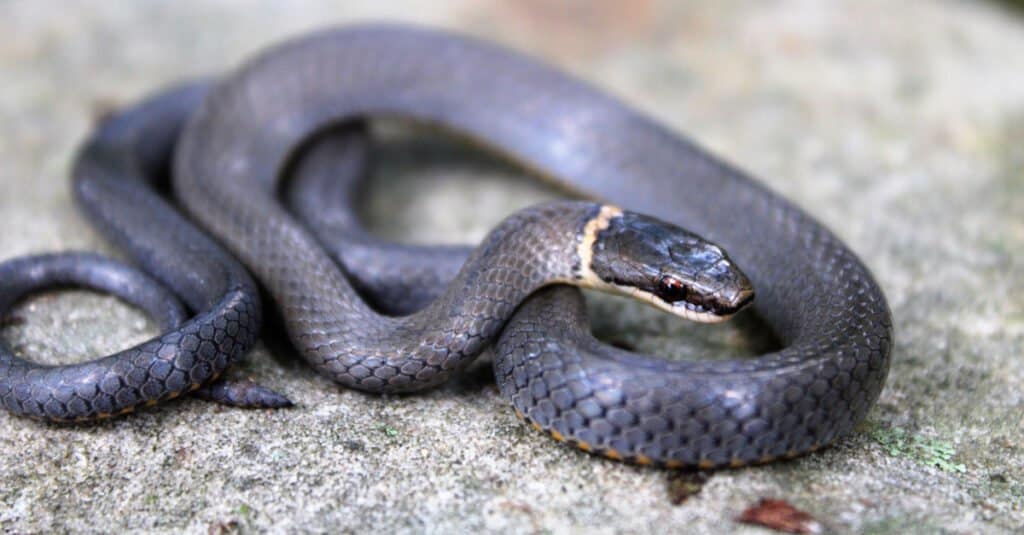
Northern ring-necked snakes like to live on the edges of forests and near deciduous trees, which there are a lot of in Wisconsin.
©Tucker Heptinstall/Shutterstock.com
Bull Snake
Bull snakes are one of the largest types of snakes. Even though they are not venomous they will often hiss or rattle their tails like a rattlesnake if they feel threatened. These snakes can grow to be a whopping eight feet long. And they like to climb trees, poles, and other things so you should definitely keep eye out above you as well as on the ground if you are in the type of area that bull snakes like to live in. Bull snakes, which are also called gopher snakes, like sandy soil that they can burrow in. In Wisconsin you will typically find them near prairie bluffs and in the drier areas of the state.

Bull snakes are not venomous but will often hiss or rattle their tails like a
rattlesnake
if they feel threatened.
©iStock.com/92968526
Milk Snake
You will find milk snakes throughout the state of Wisconsin except in the north part of the state. Milk snakes have wide red bands, which can make them look like venomous coral snakes. But don’t worry! There are no coral snakes in Wisconsin. If you see a snake that is about three feet long and has wide red bands which white bands on the sides of the red bands that’s a milk snake. It won’t hurt you. Milk snakes are very often found on farms and in dilapidated buildings. You may also see them on the edges of agricultural fields or fences.
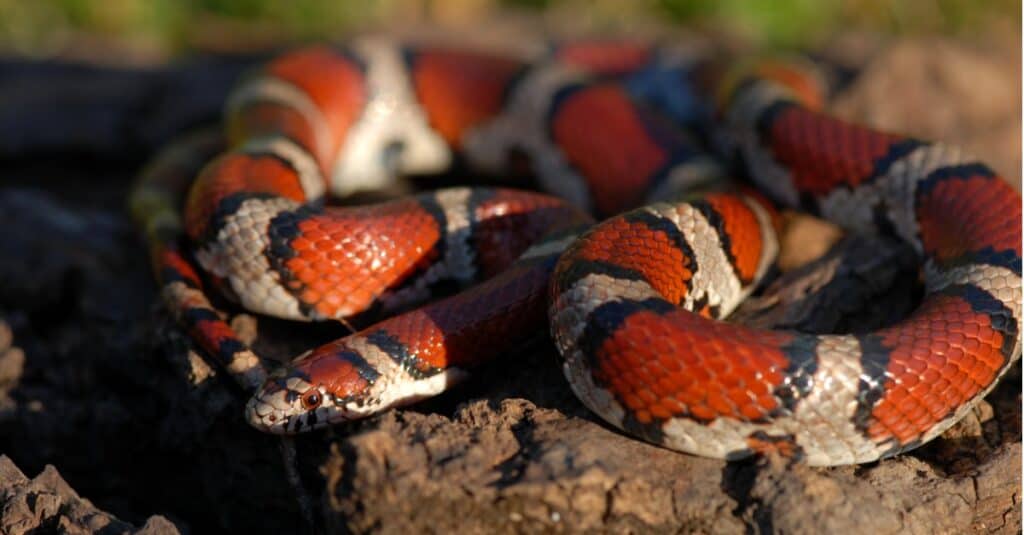
You will find milk snakes throughout the state of Wisconsin except in the north part of the state.
©iStock.com/Shoemcfly
North American Blue Racer Snake
Another snake that likes farm fields and dry forests is the North American blue racer snake. These snakes can grow to be about five to six feet long. They are very quick and can move at several miles per hour if they really want to. But the blue racer is really known for the distinctive blue color of its scales. Blue racer snakes have a very distinctive blue gray color and usually a light cream or gray belly. Even though you might be tempted to try and pick up this beautifully colored snake don’t. The blue racer isn’t venomous, but it is a wild animal and you shouldn’t bother it or try to touch it.

Blue racer snakes have a very distinctive blue gray color and usually a light cream or gray belly.
©Psychotic Nature/Shutterstock.com
Water Snakes That Live in Wisconsin
It might be a surprise considering how much water there is in in Wisconsin but there are just two types of water snakes in Wisconsin. You will find these snakes all over the state though. Wherever there are clear lakes and streams there will be these snakes:
Queen Snake
Queen snakes are only two to three feet long. They prefer warm water streams and rivers to cold lakes. That’s because their primary food are crayfish that live in small streams and rivers. The colors of a queen snake vary based on the habitat that it lives in. Queen snakes usually are either brown, tan, olive, or gray to blend into the water and the shoreline. This allows them to hunt undetected by their prey.

Queen snakes prefer warm water streams and rivers to cold lakes as they mainly eat crayfish that live in small streams and rivers.
©Jason Patrick Ross/Shutterstock.com
Common Water Snake
In Wisconsin the common water snake is very common indeed. There are water snakes throughout the entire state. Common water snakes in Wisconsin are big heavy snakes. They only get to be a few feet long but they have very wide heavy bodies. They eat crawfish, frogs, and other amphibians. The common water snake is often mistaken for a Cottonmouth snake. The Cottonmouth is venomous but the common water snake isn’t venomous.
A fast way to tell the difference is to look at the mouth. Cottonmouth snakes have white patches near and in their mouths while common water snakes don’t. There are no Cottonmouth snakes in Wisconsin. If you see a wide, heavy snake in Wisconsin in a stream or a lake there’s a good chance it’s a common water snake.

The common water snake is often mistaken for a venomous Cottonmouth snake.
©iStock.com/Doug Gordon
Venomous Snakes in Wisconsin
There are a lot of snakes in Wisconsin but there are only two kinds of venomous snakes in Wisconsin that you’ll have to look out for. They are:
Eastern Massasauga Snake
Eastern Massasauga snakes are relatively short and wide. They don’t look too dangerous, but they are venomous so you should always be careful if you see one. They are only a couple of feet long but their wide bodies make them look larger than they are. If you surprise or startle an eastern massasauga snake it may hiss or rattle its tail as a warning that you should get away. Take that warning seriously. Move slowly and deliberately to get yourself safely out of range.

Eastern Massasauga snakes are relatively short and wide. They don’t look too dangerous, but they are venomous.
©Rusty Dodson/Shutterstock.com
Timber Rattlesnake
Timber rattlesnakes are rare in Wisconsin. But you should always be watching out for them if you are hiking, working, or doing anything in the habitat they like to be in. The Timber rattlesnake has venom that is extremely potent and can kill people. Most of the time the timber rattlesnakes would rather run away from humans than attack them. These snakes are very long, typically six feet long. They have dark brown or tan coloring with black markings. Timber Rattlesnakes like to stay on the edges of forests and field, but if they are hunting they may roam throughout the forested parts of Wisconsin.

Timber rattlesnakes are rare in Wisconsin but watch out for them if hiking or doing anything in their habitats.
©Frode Jacobsen/Shutterstock.com
What State Has the Most Snake Bites?
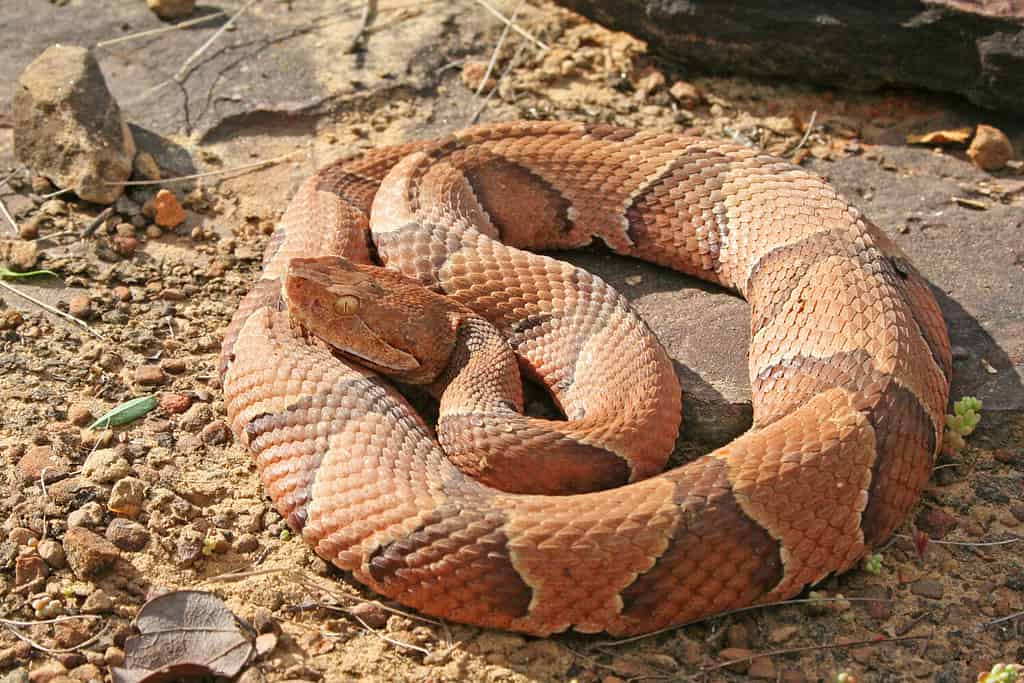
The venomous copperhead snake is among the snakes responsible for snake bites in North Carolina.
©Creeping Things/Shutterstock.com
If you live in Wisconsin, you’re in luck. Dr. Daniel Keyler, who tracked the number of snakebites in Wisconsin since 1982, found that the number of reported snake bites annually was only one! However, there are other states where snake bite numbers are quite high each year. So what state ranks the highest in snake bites? That would be North Carolina. This southeastern state’s bite rate is 157.8 bites per million population per year. How does that average out? Well, the population as of 2021 was a little over 10 million (10.55 to be exact). If we were to just figure it off of 10 million, that would mean that there are roughly 1,580 reported snake bites per year.
The top 6 states for reported snake bites are as follows:
- North Carolina–157.8 bites per million
- West Virginia–105.3 bites per million
- Arkansas–92.9 bites per million
- Oklahoma–61 bites per million
- Virginia–48.7 bites per million
- Texas–44.2 bites per million
In North Carolina, there are 6 different kinds of venomous snakes: copperhead, cottonmouth, timber rattlesnake, pigmy rattlesnake, eastern diamondback rattlesnake, and eastern coral snake. In 2019, 92 people were bitten by venomous snakes in that state.
Summary of Snakes in Wisconsin
Here’s a recap of the snakes in the state of Wisconsin that we’ve taken a close look at:
| Number | Snake | Length | Type |
|---|---|---|---|
| 1 | Smooth Green Snake | 1-2 ft | Nonvenomous |
| 2 | Western Ribbon Snake | 2 ft | Nonvenomous |
| 3 | Northern Ring-Necked Snake | 2 ft | Weak venom |
| 4 | Bull Snake | 8 ft | Nonvenomous |
| 5 | Milk Snake | 3 ft | Nonvenomous |
| 6 | North American Blue Racer Snake | 5-6 ft | Nonvenomous |
| 7 | Queen Snake | 2-3 ft | Water Snake |
| 8 | Common Water Snake | 2-4 ft | Water Snake |
| 9 | Eastern Massasauga | 2 ft | Venomous |
| 10 | Timber Rattlesnake | 6 ft | Venomous |
A Complete List of Snakes in Wisconsin
Outdoor lovers have a lot of choices when it comes to outdoor activities in Wisconsin. Hiking, kayaking, boating, and more are all fun ways to spend time in this state. But keep an eye out for snakes! The complete list of snakes in Wisconsin is:
- Butler’s Garter Snake
- Common Garter Snake
- Common Water Snake
- DeKay’s Brown Snake
- Eastern Fox Snake
- Eastern Massasauga Snake
- Bull Snake
- Eastern Hog-nosed Snake
- Gray (Black) Rat Snake
- Lined Snake
- Milk Snake
- North American Blue Racer Snake
- Northern Ring-Necked Snake
- Plains Garter Snake
- Eastern Ribbon Snake
- Prairie Ring-Necked Snake
- Queen Snake
- Red-bellied Snake
- Smooth Green Snake
- Timber Rattlesnake
- Western Ribbon Snake
- Western Worm Snake.
Other Reptiles in Wisconsin
There are other reptiles that proudly call Wisconsin home. One of them actually resembles a snake but is not. Let’s take a look at a couple below.
Slender Glass Lizard
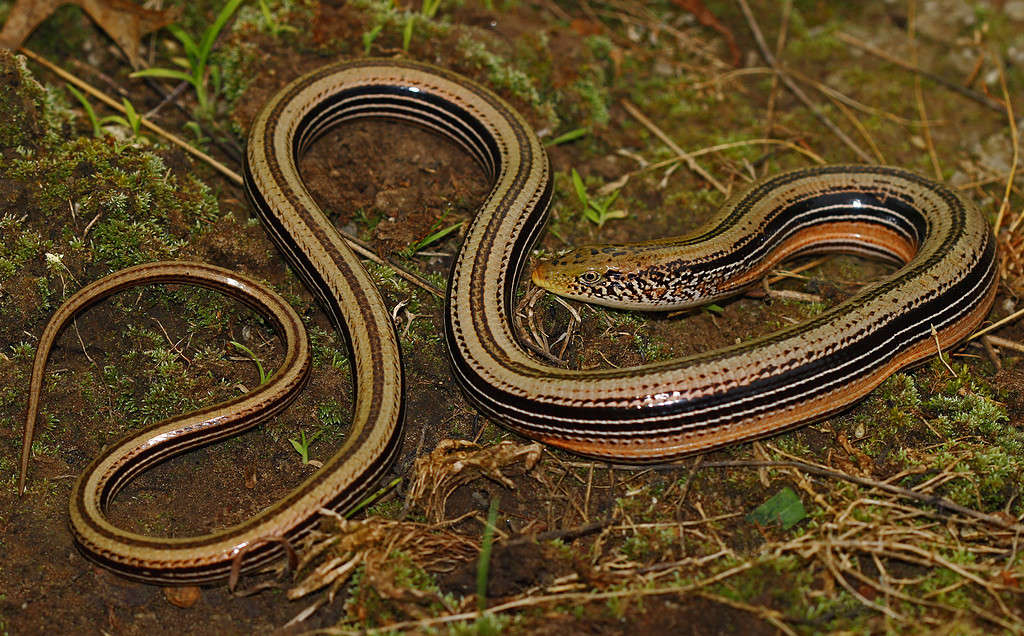
The two subspecies of slender glass lizards are the western slender
glass lizard
(pictured above) and the eastern slender glass lizard.
©Peter Paplanus / CC BY 2.0 – License
This type of lizard could easily be mistaken for a snake for the simple fact that it has no legs. One distinguishing characteristic between these lizards and actual snakes is that they have movable eyelids. If you encounter one in the wild, chances are it could very well be missing part of its tail, as its tails easily break off even without being touched. Being lizards, they mostly feed on insects and small animals and are sometimes preyed on by snakes. The slender glass lizard is listed as endangered in the state of Wisconsin by the IUCN, though it is a least-concern species in the United States as a whole.
Painted Turtle
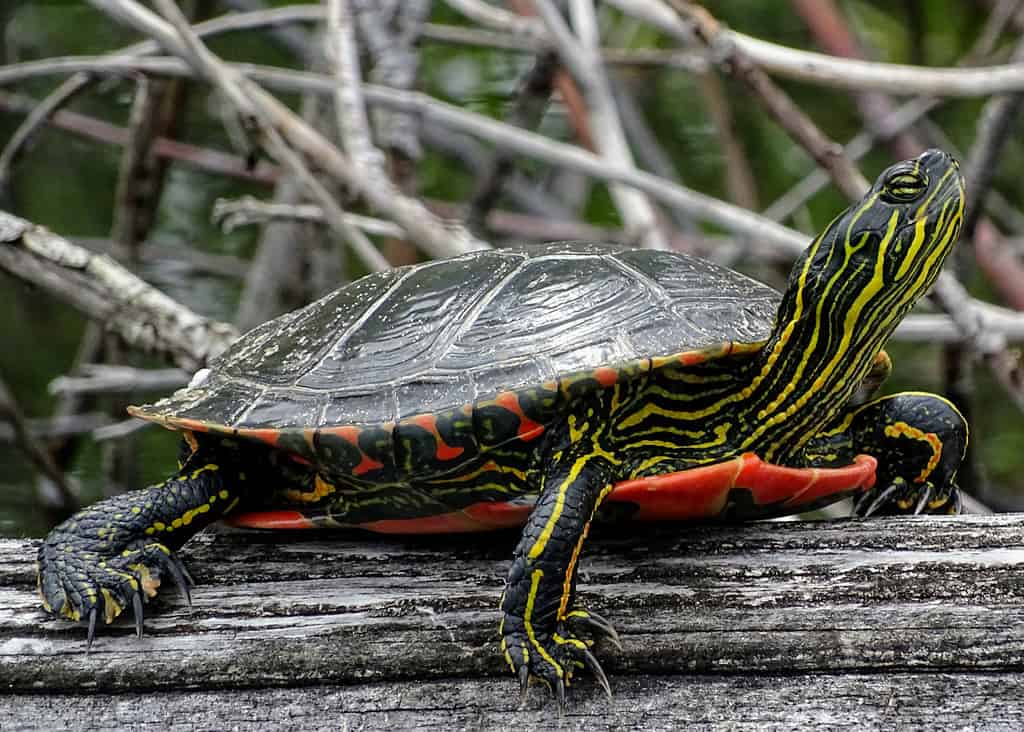
The
painted turtle
was a popular character in Native American trickster folk tales.
©iStock.com/Dave Acheson Photography
The painted turtle is a reptile found throughout the United States, including Wisconsin. In fact, the species is so popular that it’s the “official reptile” of Colorado, Illinois, Michigan, and Vermont. There’s no wonder that it thrives in Wisconsin (a state known for very cold winters) because painted turtles hibernate in mud in the cold months. They are also hearty, living an average of 55 years if they don’t fall victim to becoming roadkill.
The photo featured at the top of this post is © iStock.com/Shoemcfly
Discover the "Monster" Snake 5X Bigger than an Anaconda
Every day A-Z Animals sends out some of the most incredible facts in the world from our free newsletter. Want to discover the 10 most beautiful snakes in the world, a "snake island" where you're never more than 3 feet from danger, or a "monster" snake 5X larger than an anaconda? Then sign up right now and you'll start receiving our daily newsletter absolutely free.
FAQs (Frequently Asked Questions)
How many venomous snakes are in Wisconsin?
There are a lot of snakes in Wisconsin but there are only two kinds of venomous snakes in Wisconsin that you’ll have to look out for: Timber Rattlesnake and Eastern Massasauga Snake.
Does Wisconsin's cold weather affect the snake population?
The cold winters of Wisconsin are tough for many animals to take but the cold doesn’t seem to stop snakes from settling in Wisconsin. There are more than 20 different native snakes in this state including some water snakes that are commonly found in the state’s many lakes and rivers.
Thank you for reading! Have some feedback for us? Contact the AZ Animals editorial team.






